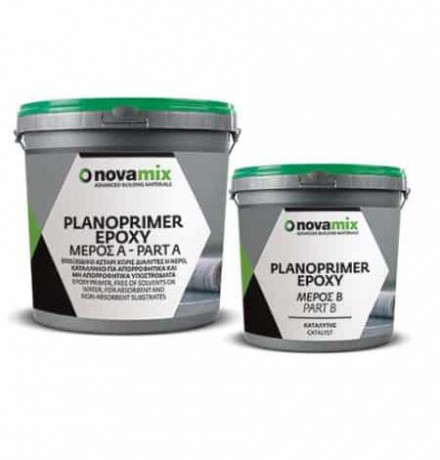
Solvent free epoxy primer for creating adhesion bridge on non-absorbent surfaces such as existing marble, ceramic tiles, metal, traces of epoxy paints in swimming pools. When applied before cement-based coatings such as PLANOCOLOR PREMIUM 2K or PLANOCOLOR PREMIUM SP microcement coatings, PLANOCOLOR GRANULATES S 500 silica sand must be scattered on the final coat, while it is still fresh. The sand that was not bonded must be removed the next day with pressurized air or by dry wiping, in order to obtain a substrate with uniform mineral surface, able to receive the cementitious coating.
• PLANOPRIMER EPOXY is suitable for priming:
o absorbent substrates that will receive cement based compounds like PLANO 120, PLANOCOLOR PREMIUM or PLANOCOLOR VENETICO under the condition that scattering with quartz sand PLANOCOLOR GRANULATES S 500 will take place on the fresh PLANOPRIMER EPOXY layer
o creating an adhesive bridge between PLANOCOAT EPX and PLANOCOLOR LIQUID GLASS layers during the process of creating decorative resin floorings
o enhancing of the adhesion of epoxy coatings like PLANOCOLOR LIQUID GLASS on non absorbents substrates
• Form: liquid
• POt life: ≈ 60 minutes
• Walkability: after 4 hours
• Coverings application: after 6 hours
• Application temperature: from +10°C up to +30°C
• Substrate preparation:
• The application substrate must be solid, clean and dry, free of humidity, dust, loose parts, oil, old paints, rust and other materials that might compromise the adhesion of PLANOPRIMER EPOXY to the substrate. Remove these materials by mechanical means. The application substrate mustn’t be wet and cracks in the substrate must be repaired first with the two component epoxy adhesive EPO FLUID. Parts of carbonated concrete must be removed; the reinforcing rods must be well cleaned and treated with NOVAFER prior to the application of the fibre reinforced mortar RC 340. When applying PLANOPRIMER EPOXY upon non absorbent surfaces, such as existing ceramic tiles, these must be adequately bonded to the substrate and not subjected to rising dump. Non absorbent surfaces such as mosaics, ceramic tiles should be well cleaned from grease or oil stains and existing loose parts should be removed.
• Preparing the mix:
• Component A (resin) and B (catalyst) are already in the correct proportions. Pour all the comp. B into the bucket containing the comp. A and mix by using an electrical mixer in low rpm (300 rpm) for 2 - 3 minutes. It is important to mix carefully both the bottom and the lateral sides of the bucket in order for the catalyst to spread evenly. Let the mix rest for a few minutes and proceed with the application taking care of the working time of the mix. The mixing ratio is 1,9 : 1,1. Never mix partially the two components otherwise there is danger that the product will not set properly.
• Applying the mix:
• The temperature application range for PLANOPRIMER EPOXY is between +10°C and +30°C. Apply the mix by means of a brush or a roller in one layer. If the layer which will follow is cement based it is required and as long as it is fresh, to scatter quartz sand PLANOCOLOR GRANULATES S 500 taking care to cover the entire primed surface. After the hardening of the primer, all the sand grains that haven’t been adhered must be removed with a powerful vacuum cleaner. This is very important in order to create the adhesion bridge for the cement based covering that follows. Special care should be taken during the scattering process upon the fresh layer of the primer in order to achieve full coverage and create an adhesive bridge for the coverings that follow otherwise "empty" spots will cause spot detachments. Usually this adhesive bridge can be set to foot traffic after 4 hours and can receive coverings after 6 hours depending on type of the application. If the subsequent layer is epoxy or polyurethane based, there is no need to create an adhesive bridge with silica sand. In these cases it is important to apply the epoxy or polyurethane layer within 2 - 20 hours after the PLANOPRIMER EPOXY application; otherwise an additional coat of primer should be applied.
